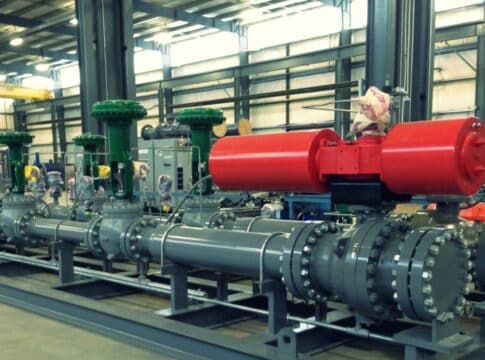NiSource and Sempra Energy Lead the Way in Hydrogen Blending
In the race toward a sustainable future, hydrogen has emerged as a star player in the global clean energy transition. Among the companies embracing this transformative shift are NiSource Inc. and Sempra Energy, which are taking proactive steps to harness the potential of hydrogen as a key driver of a greener energy landscape.
NiSource just launched a multi-phase hydrogen blending project; it’s a pioneering project in the U.S. to use a blending skid in a controlled environment to combine natural gas and hydrogen at precise levels. The goal is to find out the best blend percentages and their benefits for consumers and the planet.
Taking the same direction, San Diego-based Sempra Energy, will also test electrolytic hydrogen blending into existing natural gas infrastructure. The energy giant is also working on what could be the nation’s largest green hydrogen energy infrastructure system.
NiSource Hydrogen and Natural Gas Blending
NiSource envisions the potential for substantial investments in hydrogen production, transportation, and storage. It comes following the conclusion of its current five-year $15 billion capital plan in 2027.
To make that vision a reality, NiSource is developing its capacity to handle hydrogen safely and efficiently. It also seeks to show to policymakers that low-carbon hydrogen can effectively decarbonize gas utility services.
RELATED: What Is Hydrogen And Why Is It Revolutionizing Energy
Several hydrogen projects have been announced in the U.S., encompassing different areas of application.
NiSource pilot project, led by its subsidiary Columbia Gas of Pennsylvania Inc., will test a 20% hydrogen blend in natural gas distribution infrastructure. It facilitates the regulated blending of hydrogen into Safety Town’s natural gas system at varying concentrations.
The results of this project to be tested in Monaca, Pennsylvania will be key to demonstrate that hydrogen blending is feasible. The project is a collaboration between NiSource’s Columbia Gas and EN Engineering.
Together, they’ll create a blending skid that will inject hydrogen into the gas stream at different percentages, from 2% – 20%.
The project will also assess the impact of various blending concentrations on different gas appliances through a model home. The goal is to ensure the proper functioning of equipment and to know if any adjustments on processes are necessary.
NiSource prioritizes safety and regulatory compliance in hydrogen blending. They will share data with the US Pipeline and Hazardous Materials Safety Administration for monitoring hydrogen-gas blends and their impact on pipeline materials.
Moreover, its other subsidiary, Northern Indiana Public Service Co. LLC (NIPSCO), plans to use a blend of gas and hydrogen to repower one of its turbines.
An Alternative to Electrification
In all these innovations, CEO Lloyd Yates emphasizes the importance of policies in incentivizing efforts driving the hydrogen transition.
RELATED: Lone Cypress Energy Project Revolutionizes Hydrogen
He specified some federal tax credits and initiatives such as the Appalachian Regional Clean Hydrogen Hub (ARCH2). NiSource backed this application to secure a subsidy from the Energy Department’s funding program on setting up regional hydrogen hubs.
The Indiana-based utility aims to achieve net zero Scope 1 and 2 emissions by 2040. Hydrogen blending can further help the company tackle its elusive Scope 3 emissions, which are linked to customer’s gas use. Burning hydrogen as a fuel emits only water vapor, no greenhouse gasses given that it uses renewable sources.
NiSource said its hydrogen and natural gas blending strategy is part of their “Future of Energy” program. It particularly includes renewable energy and electrification strategies as well as renewable natural gas pathways.
Yates further noted that the project seeks to make hydrogen an alternative to electrification for customers facing financial challenges. It will allow them to reduce their carbon emissions without buying new appliances, thus making it a viable option.
Sempra’s Growing Sustainability & Hydrogen Innovation
Along with NiSource, other utilities like Sempra Energy are also exploring hydrogen projects to meet the nation’s clean energy goals.
With a strong focus on sustainability, Sempra pursues >20 hydrogen R&D projects to enhance grid resilience and promote decarbonization. It works with strategic research partners while providing funding worth $140 million in the last 2 years.
The funds are for research, development, and demonstration projects for cleaner fuels, hydrogen technology and infrastructure.
In particular, Sempra’s subsidiary Southern California Gas Co. (SoCalGas) partners with the University of California, Irvine on a demonstration project. They aim to show how electrolytic hydrogen can be safely mixed into the campus’ existing natural gas pipeline. Testing for this hydrogen-natural gas blending may start next year once approved.
The joint initiative aims to better understand how hydrogen could be delivered at scale through California’s existing natural gas system. It can either be for existing customers tapping at the grid or to produce clean electricity in zero-emissions fuel cells.
RELATED: First Hydrogen’s Fuel Cell EV Receives Positive Analysis From Rivus
The testing project will use an electrolyzer to convert water into hydrogen for blending into the UCI campus gas grid. It will involve powering residential and light commercial equipment such as ovens, boilers, furnaces, and water heaters.
Water Electrolysis Method
Initially, SoCalGas will use 5% hydrogen in the mix, aiming for up to 20%, the same as NiSource’s blending project. The ultimate goal is to also significantly reduce customer’s emissions from gas use.
The Missing Link in the Clean Energy Equation
SoCalGas announced its goal to reach net zero greenhouse gas emissions by 2045. That makes it the first large natural gas utility in the country to do so. Its parent company, Sempra, pledged to achieve net zero emissions 5 years later, by 2050.
The energy firm also proposed the Angeles Link, which could be the country’s largest green hydrogen energy infrastructure system. They refer to it as the missing link in the clean energy equation.
The initiative can potentially deliver cleaner energy to hard-to-electrify sectors such as heavy-duty transportation and industrial processes.
By replacing fossil fuel-powered trucks with hydrogen fuel cell trucks, Sempra Energy aims to eliminate up to 3 million gallons of diesel a day. This would result in displacing about 25,000 tons of carbon emissions each year.
First Hydrogen (TSXV: FHYD), a Vancouver and London-based company, specializes in zero-emission hydrogen fuel cell vehicles (FCEV) and green hydrogen production. Its innovation is a testament that FCEV works, with trial results beating test expectations.
NiSource and Sempra Energy’s initiatives in hydrogen blending exemplify their commitment to a sustainable energy future, reducing emissions while ensuring affordable and accessible solutions for consumers. If their efforts turn out successfully, they can show the significance of hydrogen in the clean energy transition.
Disclosure: Owners, members, directors and employees of carboncredits.com have/may have stock or option position in any of the companies mentioned: FHYD
Carboncredits.com receives compensation for this publication and has a business relationship with any company whose stock(s) is/are mentioned in this article
Additional disclosure: This communication serves the sole purpose of adding value to the research process and is for information only. Please do your own due diligence. Every investment in securities mentioned in publications of carboncredits.com involve risks which could lead to a total loss of the invested capital.
Please read our Full RISKS and DISCLOSURE here.
The post NiSource and Sempra Energy Lead the Way in Hydrogen Blending appeared first on Carbon Credits.



